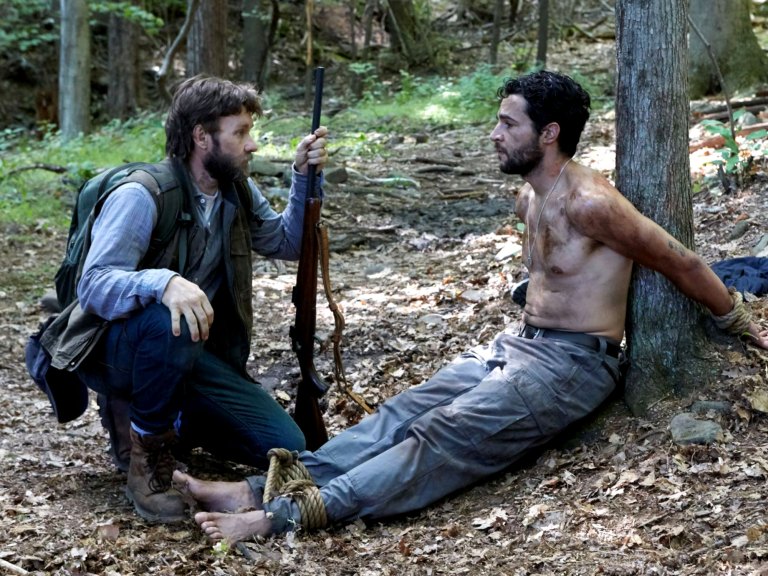Did You Catch The Little Way ‘It Comes At Night’ Is Just Like ‘The Shining’?
“To me, it’s even more exciting what that situation does to the people, what the fear and paranoia instills.”

2017’s It Comes at Night is currently one of the scariest movies streaming on Netflix. The psychological horror movie focuses on two families in the aftermath of an extremely contagious virus that has already destroyed civilization. One family—Paul, Sarah, and their son Travis—make their postapocalyptic life in a remote cabin in the woods. They catch Will breaking into their home but eventually believe his story that he thought the cabin was abandoned and was simply searching for supplies to help his wife and son survive. Though they are each distrustful, the two families decide to live together at the cabin, hoping to increase the odds that they can survive together.
Inside the cabin, Paul explains that they keep the only door locked at all times, and Paul wears the only key around his neck. Still, one night Travis wakes to find the door open. The families decide to stay in their rooms and quarantine for a few days. The cabin that has served as a source of protection from the outside world becomes an unsettling place where no one can be trusted.
The plot of It Comes at Night bears a vague resemblance to another famous horror story about a family living in isolation in a remote location where they begin to distrust each other while facing malevolent outside forces. That story is about the Torrance family Stephen King wrote about in The Shining. This novel was famously adapted by Stanley Kubrick in 1980, and his version of The Shining became one of the most beloved and popular horror movies of all time.
This similarity isn’t an accident. It Comes at Night writer and director Trey Edward Shults has said in interviews that Kubrick’s The Shining and George A. Romero’s Night of the Living Dead (1968) were his inspirations in creating the film. Shults even used one filmmaking trick originated by Kubrick in The Shining. Like the hotel in Kubrick’s film, the cabin in It Comes at Night has a nonsensical floor plan. The characters move around from room to room, and the audience follows them, likely only unconsciously aware that their movements don’t actually make sense, because no real building could have the layout this cabin appears to have. This creates a sense of unease in the viewer that heightens their anxiety as they watch the horror play out on-screen.
If you’re having trouble visualizing what this looks like, here’s a quick explainer of how Kubrick used this strategy:
In an interview with Slash Film, Shults explains his decision to create an impossible floor plan for the cabin where most of his film is set:
I always saw the house as this kind of labyrinth, the mesh of Travis’ head, if that makes sense in a pretentious way. And past that, I would see the house metaphorically, as a microcosm for this society and these two tribes. Just two families, you know what I mean? The house is so huge [to] me. Also, since we’re dealing with nightmares and headspace and stuff, I never wanted it to be super clear [that] “This is where this is and this is where this is.” The Shining was a huge touchstone for that. The Overlook is the best ever in any movie.
Trey Edward Shults, interview with Slash Film
In another interview, Shults says he isn’t interested in pandemics or monsters or evil people as much as he is interested in how normal people react to those things:
People fascinate me, and dynamics between people fascinate me. Looking at one of my favorite horror movies, The Thing, I know everyone goes crazy about the monster effects and all of that. It’s dope, but to me, it’s even more exciting what that situation does to the people, what the fear and paranoia instills.
Trey Edward Shults, interview with The Verge
Fittingly, It Comes at Night premiered at a film festival celebrating the legacy of Kubrick’s The Shining—the Overlook Film Festival at Timberline Lodge in Oregon. The Timberline Lodge was used by Kubrick for exterior shots of the fictional Overlook Hotel. The Stanley Hotel in Estes Park, Colorado served as the real-life inspiration for Stephen King’s novel. King went on to write and produce his own adaptation of his novel filmed in 1997 at the Stanley Hotel because he was unsatisfied with Kubrick’s work.
Unlike Kubrick’s film, however, It Comes at Night was well-reviewed by critics when it came out. It still holds an 87% rating on Rotten Tomatoes. Fans tend to like the movie slightly less than critics do, which is the inverse of the critical reception to The Shining.
In an interview with Slash Film, Shults used a host of other “tricks” to make It Comes at Night scary in addition to the cabin’s labyrinthine layout. He said it was important for him that audiences “experience the film how the characters do.” He played with lenses, aspect ratio, lighting, and sound—all to better immerse viewers in the story and get them to feel like they might be part of a third family living in the cabin’s maze. Since the movie is currently streaming on Netflix, it’s a good time to give it a first or second watch. Can you tell the ways in which the director tried to create a creepy atmosphere through the technical way the film is put together? Did you notice that the layout of the cabin feels wonky? It Comes at Night is one of those horror movies where each time you watch, you will notice new layers that the director built into the story and the psychological and physiological effects they have on you as a viewer.
